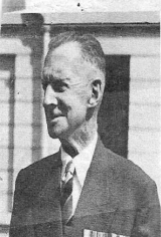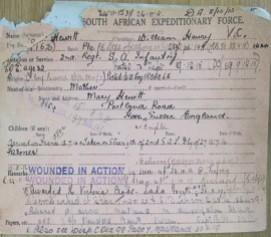Lance Corporal William Henry Hewitt VC, (aged 33) of 2nd South African Infantry Regiment is a very special South African, seen here he maintains his traditional wry smile, he had lost some teeth in heroic actions which earned him the Victoria Cross and he figured women wouldn’t think him attractive if he smiled. All we can say is smile, you of all people really earned it!

L/Cpl William Hewitt VC – Note his two ‘wound stripes’ on his sleeve
William was an exceptionally brave man, he was awarded the Victoria Cross for action near Ypres, Belgium, on September 20, 1917. These extracts from “The Comprehensive Guide to Victoria Crosses” and “How I won the Victoria Cross” the story of Major William Hewitt from the Hermanus historical society outline a very colourful life and the depth of character that was William Hewitt VC, read on and learn about one very remarkable South African.
Consider his own recollection of the action that earned him the Victoria Cross and you’ll have the measure of the man and his off the cuff ‘dark’ military humour:
William Hewitt’s platoon was ordered to demolish a German pillbox, manned by 15 enemy soldiers. Within a minute of advancing his entire platoon was killed by an artillery shell, William was luckily the sole survivor. He advanced alone and threw a grenade into the pillbox. A “jampot” (Improvised Explosive Device) was thrown at him and hit him in the face. Of the resulting explosion he said:
‘Apart from blowing off my gasmask and half my clothes, knocking out four teeth, breaking my nose, giving me a couple of black eyes, with a lot of little cuts here and there and knocking me backwards into a convenient shell-hole, it didn’t really do any damage – only made me damn mad’.
William Hewitt went round the back of the pillbox and pushed his last grenade though a breathing hole. It exploded inside, killing all the occupants. He ran around the front to deal with any survivors, only to hear a Sergeant of a relieving platoon say: ‘There’s fifteen in there Sir, and they’ve all had it.’
The “jampot” is what would now be regarded as a IED – an improvised explosive device in a modern context, back in World War 1, it was exactly that. Literally, it was a jam pot (or tin), taken out of the rubbish dump, filled with nuts and bolts, with an explosive device and then thrown at the enemy if all else had failed.

A wounded South African soldier is given a hot drink by a padre after the attack on ‘Potsdam’, a German stronghold near Zonnebeke, during the Battle of the Menin Road Ridge near Potijze, 20 September 1917 (same day and attack in which William Hewitt won his VC).
Now that is some account to earn a Victoria Cross, let’s have a look at this man and how he came to taking out a pillbox single-handedly.
Origins
William Henry Hewitt (1884-1966) was born on 19th June 1884 at Copdock, near Ipswich, Suffolk. His father, also William Henry Hewitt, was born in London, and was a farmer of 80 acres at Preston Farm, Harrow-on-the-Hill, Middlesex. William (junior) had six siblings, including a brother George, who was killed serving in the Boer War in South Africa in 1900.
William Hewitt (junior) emigrated to South Africa in 1905 and served in the South Africa Constabulary and later the Natal Police, including during the Zulu Rebellion in 1906. He later became a farmer in Natal.
World War 1
William volunteered to take part in World War 1 and enlisted in the Union of South Africa Defence Force on 24th November 1915. He went to France on 12th July 1916 and joined the 2nd South African Infantry Regiment on 15th July.

He fought at the very deadly Battle of Delville Wood were he was very lucky to survive and later he also fought at the Butte de Warlencourt as a Lewis Gunner in 2 Platoon, B Company. Having been wounded in the leg on 12th October, he was evacuated to England on 24th October, where he was treated at Tooting Military Hospital. He returned to France in April 1917 and was promoted to Lance Corporal the following month.
Victoria Cross
On 20th September 1917 east of Ypres, the 2nd South African Infantry Regiment (2nd SAI) had to ‘leapfrog’ the 4th South African Infantry Regiment and advanced towards Bremen Redoubt. The 2nd SAI came under enfilading fire from Hill 37 and Tulip Cottages. In the meantime, the terrain became a quagmire, with men struggling waist deep in the mud. It was during this second stage in the battle that L/Cpl William Henry Hewitt captured a pillbox single-handedly.

Destroyed strong concrete redoubt, in the Ypres sector in Belgium, during the battle on 20 September 1917. Same day and same attack that William Hewitt won his VC.
He threw a grenade into a doorway, but the Germans threw a improvised bomb back at him that blew off Hewitt’s gas-mask and knocked out four of his teeth. He was furious because he was engaged to be married and now feared that his fiancée might no longer find him attractive, Hewitt reached the rear of the pillbox. He tried to lob a bomb through a loophole, but missed and had to dive for cover. With only one bomb remaining, Hewitt crept right up to the loophole and, from beneath it, pushed the grenade through, receiving a shot in his hand as he did so. He eventually succeeded in arresting a number of Germans. Fifteen others lay dead in the pillbox. William, a simple farmer from Natal had earned the Victoria Cross.
William Hewitt was evacuated due to his wounds on 1st October, and was presented with the VC by King George V at Buckingham Palace on 16th January 1918 and was appointed Acting Sergeant on 1st April. His Victoria Cross Citation reads:
“For most conspicuous bravery during operations. Lance Corporal Hewitt attacked a pill-box with his section and tried to rush the doorway. The enemy garrison, however, proved very stubborn, and in the attempt this non-commissioned officer received a severe wound. Nevertheless, he proceeded to the loophole of the pill-box where, in his attempts to put a bomb into it, he was again wounded in the arm. Undeterred, however, he eventually managed to get a bomb inside, which caused the occupants to dislodge, and they were successfully and speedily dealt with by the remainder of section.”

Three German prisoners, one wounded, captured in the attack on Vampire Farm near Potijze by South African and British forces, during the Battle of the Menin Road Ridge, 20 September 1917 (same day and attack in which William Hewitt won his VC).
A life less ordinary
William married Lily Ollett in October 1918. She was a shorthand typist. They had met when he was a patient at Tooting Military Hospital in October 1916. William returned to South Africa on RMS Durham Castle on 22nd April 1919 and was discharged the following day. He continued farming until 1925, when they moved to East Africa. He ran a coffee farm there until he sold it in 1939 to rejoin The South African Union Defence Force as a Commissioned Officer at the on-set of World War 2.
During World War II, William Hewitt VC, now promoted to a Major fought the next World War in Mombasa, East Africa were he acted as a liaison officer and later as an assistant provost-marshal.
William and Lily were living in Nairobi in 1952. When his health started to fail in 1950, he retired to Hermanus on the Cape Coast and finally became a South African citizen in 1955. He returned to Britain to attend the 1956 VC Centenary Celebrations in Hyde Park, London. In the late 1950s, he had been diagnosed with cancer of the larynx and had to have his larynx removed in Cape Town. In the operation, they found shrapnel embedded there. Shortly after the operation, he developed Parkinson’s Disease
Lily brought him back to Britain in 1961 in an attempt to find a cure with a Parkinson’s specialist in Edinburgh. He fell badly twice in his later years and had two severe bouts of pneumonia. Although crippled, unable to speak and almost helpless, he continued the best he could.
William died at Delancey Hospital, Cheltenham, Gloucestershire on 7th December 1966. He was cremated at Cheltenham Crematorium on 10th December and his ashes were returned to South Africa where they were scattered at sea off the beautiful Hermanus Cliffs in South Africa on 2nd January 1974, this scenic location is famous for whale-wacthing and annually South Africa’s migrating Southern Right Whales are seen close to the cliffs as they calve. It is also the appropriate location for Hermanus’ war memorial.
What a fitting place for one of South Africa’s bravest to laid to rest.
William Hewitt VC – medals
In addition to his Victoria Cross (VC) , William was also awarded the Natal Rebellion Medal 1906, British War Medal 1914-20, Victory Medal 1914-19, 1939-45 Star, Africa Star, War Medal 1939-45, George VI Coronation Medal 1937, and Elizabeth II Coronation Medal 1953. The VC was presented to Framlingham College by his widow in May 1967. It was held in the Chapel until the College loaned it indefinitely to the Imperial War Museum on 23rd April 2004. It is displayed in the Ashcroft Gallery. The Castle Military Museum in Cape Town owns four of his campaign medals. The other medals’ location are unknown.”
Related Work and Links:
Reginald Hayward VC “Superhuman powers of endurance and courage” Reginald Hayward VC
William F. Faulds VC Taking gallantry at Delville Wood to a whole new level; William Faulds VC MC
Sherwood Kelly VC “…. a Herculean of Irish-South African origin with a quite remarkable disregard for danger”.
Percy Hansen VC One Lucky Charm wins the Victoria Cross; Percy Hansen VC, DSO, MC
Andrew Beauchamp-Proctor VC ‘Proccy’ – South Africa’s ‘Bravest of the Brave’
Written and Researched by Peter Dickens
Extracts from “How I won the Victoria Cross – Story of Major William Hewitt” – Hermanus Historical Society and Dr Robert Lee. Image of L/Cpl Hewitt copyright IWM Colour Image Colourised by Doug UK. Extracts and later images of William Hewitt taken from ‘The Comprehensive Guide to the Victoria and George Cross’ on-line. Images as shown copyright Imperial War Museum.






My grandfather , adjudant Juliaan Louwagie. Belgian army , fought that entire war . He was a hero ! I still have his uniform . I live in Blankenberge , 35 km from Ypres and know the battlefields very well .
LikeLike
Pingback: Under deadly fire he directed his tanks to their objective … on foot! Clement Robertson VC | The Observation Post
Pingback: “Bravery in the face of desperate circumstances” Oswald Reid VC | The Observation Post
Pingback: A Colonel who single-handedly rushed machine gun posts; Harry Greenwood VC | The Observation Post